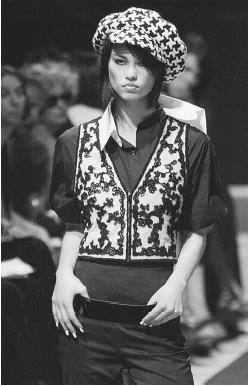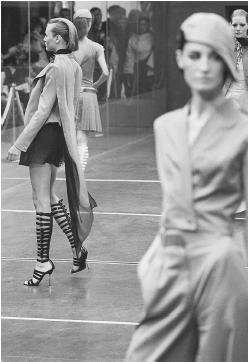Karl Lagerfeld - Fashion Designer Encyclopedia
German designer
Born: Hamburg, 10 September 1938; immigrated to Paris in 1952. Career: Design assistant at Balmain, 1955-58; art director, Patou, 1958-63; freelance designer for Chloé, Krizia, Ballantyne, Timwear, Charles Jourdan, Valentino, Fendi, Cadette, Max Mara and others, from 1964; launched Parfums Lagerfeld, 1975; director of collections and ready-to-wear, Chanel, from 1983; Karl Lagerfeld and KL ready-to-wear firms established in Paris and Germany, 1984; Karl Lagerfeld, S.A., acquired by Chloé parent company, Dunhill Plc., 1992; broke ties with Chloé and Dunhill (part of the Vendome Group), 1997;

Publications
By LAGERFELD:
Selected Books
Karl Lagerfeld: A Fashion Journal—A Visual Record of Anna Piaggi's Creative Dressing and Self-Editing, with Anna Piaggi, New York, London & Stuttgart, 1986.
Gilbert Poillerat, Maître Ferronnier, with François Baudot, Paris,1992.
Karl Lagerfeld: Off the Record, Göttingen, Germany, 1994, 1995. Chanel, Paris, 1995.
Karl Lagerfeld: Grunewald, Göttingen, 1995.
Claudia Schiffer, London, 1995.
Visionen, Göttingen, 1996.
Body Parts, Cologne, 1997.
Karl Lagerfeld: Parti Pris, Bonn, 1998.
The House in the Trees and Casa Malaparte, both with Eric Pfrunder and Gerhard Steidl, both Göttingen, 1998.
Aktstrakt, Göttingen, 2000.
Escape From Circumstances, Göttingen & London, 2000.
editor, Iwao Yamawaki, Göttingen & London, 2001.
Modern Italian Architecture, Göttingen & London, 2001.
On LAGERFELD:
Books
Milbank, Caroline Rennolds, Couture: The Great Designers, New York, 1985.
Piaggi, Anna, Karl Lagerfeld: A Fashion Journal, London, 1986.
Perschetz, Lois, ed., W, The Designing Life, New York, 1987.
Howell, Georgina, Sultans of Style: Thirty Years of Fashion and Passion 1960-1990, London, 1990.
Stegemeyer, Anne, Who's Who in Fashion, Third Edition, New York, 1996.
Articles
Buck, J., "How Karl Lagerfeld Changed Some Lives," in Interview (New York), March 1973.
"Great Designers of the World: Karl Lagerfeld," in Vogue (London), 1 March 1975.
Menkes, Suzy, "The Man Who Takes Over at Chanel," in the Times (London), 31 January 1983.
Shapiro, Harriet, "Tout Paris Applauds the Fashionable Vision of Karl Lagerfeld," in People, 11 June 1984.
"Karl Lagerfeld: The Many Faceted Man," in Vogue (Paris), October 1985.
Dryansky, G.Y. "Baroque to His Bones," in Connoisseur, December 1985.
Barron, Pattie, "Playing Court to Kaiser Karl," in Cosmopolitan (London), October 1986.
"A Life in the Day of Karl Lagerfeld," in the Sunday Times Magazine (London), 8 November 1987.
Barker, Rafaella, "Karlsberg," in House & Garden, December 1987.
Lobrany, Alexander, "Lagerfeld Logs On: At 50, King Karl Makes a Foray into Men's Wear," in DNR, 6 April 1988.
Brook, Danae, "King Karl," in the Sunday Express Magazine (London), 15 May 1988.
Talley, André Leon, "Petit Palais," in Vogue, April 1989.
Ciavarella, Michele, "Karl Lagerfeld: A Burst of Genius," in Maglieria Italiana (Modena), April/June 1989.
Bowles, Hamish, "Reviving the Past," in Harpers & Queen (London), September 1989.
"A Lagerfeld Extravagance," in the Independent (London), 28 September 1989.
Mynott, Lawrence, "Kaiser Karl: The Darling Dictator," in the Independent, 24 May 1990.
Etherington-Smith, Meredith, "He Came, He Drew, He Conquered," in Harpers & Queen, September 1990.
Mower, Sarah, "Karl Lagerfeld," in Vogue (London), April 1991.
Mayer, Margit, "King Karl," in WWD, 20 November 1991.
Orth, Maureen, "Kaiser Karl: Behind the Mask," in Vanity Fair, February 1992.
"The Kaiser's Empire," in WWD, 2 June 1992.
Lane, Anthony, "The Last Emperor," in the New Yorker, 7 November 1994.
Menkes, Suzy, "Chanel: Beauty Without Gimmicks," in the International Herald Tribune, 25 January 1995.
Spindler, Amy M., "Four Who Have No Use for Trends," in the New York Times, 20 March 1995.
White, Constance C.R., "Lagerfeld's Poetic License," in the New York Times, 24 June 1997.
Gabor, Lisa, "No Clothing, No Kidding," in In Style, March 1998.
White, Constance C.R., "Lagerfeld's Lesson for Younger Designers: Stay Relevant," in the New York Times, 16 March 1999.
Menkes, Suzy, "Magnificent Chanel Defines the Season," in the International Herald Tribune, 4 March 2000.
——, "Class and Classics at Chanel," in the International Herald Tribune, 24 January 2001.
Horyn, Cathy, "A Slimmer Karl Lagerfeld Makes his Concession to Fashion," in the New York Times, 19 June 2001.
Menkes, Suzy, "Chanel Goes to the Head of the Class," in the International Herald Tribune, 11 July 2001.
***
Universally recognized as one of the most prolific and high-profile designers of the last 20 years, Karl Lagerfeld has maintained his reputation through consistently strong work for the numerous lines he produces every year. Each label has its own distinct look, while clearly bearing the bold, uncompromising Lagerfeld signature that guarantees the success of everything he produces.
Moving between several main collections, Lagerfeld designs with consummate ease, displaying the skills he learned from his couture background in fine tailoring and flashes of surreal detailing. He has functioned best as a catalyst, reinvigorating labels and broadening their customer base. Since 1983 he most spectacularly demonstrated this capability at Chanel, where, despite some criticism, Lagerfeld brought the label back to the pinnacle of high fashion. He produced endless innovative variations on the signature tweed suits that often mix street style references, such as teaming the traditional Chanel jacket with denim miniskirts and the signature gilt buttons and chains.
Lagerfeld also stretched the Chanel look to embrace younger customers, with club-influenced black fishnet bodystockings, the traditional Chanel camellia placed cheekily over the breasts, and hefty lace-up boots set against flowing georgette skirts and leather jackets. This combination of wit with recognizable Chanel symbols rejuvenated the house, making Lagerfeld's fashion word an inspirational message to a new generation. His experiments have been at their most fantastic in the vibrant lines of the couture show, made more accessible in the ready-to-wear range. Only Lagerfeld could put the Chanel label on panties (1993) and camellia-trimmed cotton vests (1992) to make them the most talked-about elements of the Paris collections. Yet this quirkiness was underpinned by the quality of Lagerfeld's designs and the mix of classic separates that have always been an undercurrent in his work.

His own name label, KL, highlights these skills. Bold tailoring, easy-to-wear cardigan jackets in his favorite bright colors, combined with softly shaped knitwear, showed the breadth of his talents and ensured the longevity of his appeal. If his more outrageous combinations at Chanel have enabled him to outlive the excesses of the 1970s that trapped some of his contemporaries, then his clever manipulation of fabric and color has prolonged the life of his clothes still further.
During the 1970s Lagerfeld's work for Chloë was equally influential, his love of eveningwear coming to the fore, albeit in a more restrained form than at Chanel. The main look of this period was flowing pastel chiffon draped onto the body to give a highly feminine feel and trimmed with silk flowers. He recreated this style for his return to the label in spring-summer 1993, complete with models wearing Afro wigs. At first coolly received by the fashion press, it went on to inspire many with its floaty silhouette and flower-child air, reviving ethereal dresses with no linings, unnecessary seams, or extraneous detail.
While he continued to move from label to label, never quite losing the freelance mentality of his early days, it is only the occasional lack of editing in his collections betraying how widely his talents are spread. Idea follows idea, frequently inspired by his current model muse as he reinterprets garments to create very modern styles. At Fendi this desire to continually push forward to greater modernity, absorbing the influences around him and seeking greater perfection in his work, led to his taking the furriers' trade a step further. The lightness of touch that had established his name as early as 1970 led him to strip the Fendi sisters' signature fur coats to the thinnest possible layer. He removed the need for heavy linings by treating the pelts to produce supple lightweight coats shown in 1973 with raglan sleeves and tie belts, which complemented the sporty feel of the knitwear he also produces for the company.
Lagerfeld has proven he is equally adept in his bold strokes at Chanel as in his delicate shaping at Fendi, or in the vibrant classics of his own lines. Though he severed his ties with Chloé and the Vendome Group in 1997 (and regained ownership of the company bearing his name), Lagerfeld had more than enough designing to keep him busy. He also continued to indulge in another passion, photography, producing a pictorial of nude celebrities for Visionaire magazine in 1998. He has published a growing collection of books on art, architecture, and photography, and collaborated with authors the likes of Helmut Lang, Peter Lindbergh, and Madonna.
Lagerfeld's consummate skills as a designer have enabled him to push the fashion beyond its constraints by combining the immediacy of ready-to-wear with the splendor and elegance of couture. Nearly two decades ago, in June 1984, Lagerfeld told People magazine's Harriet Shapiro, "I would like to be a one-man multinational fashion phenomenon." In both the 20th and 21st centuries, Karl Lagerfeld has more than achieved his goal.
—Rebecca Arnold;
updated by Sydonie Bénet
Comment about this article, ask questions, or add new information about this topic: